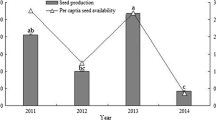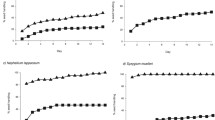Abstract
Based on the animal dispersal hypothesis and the predator satiation hypothesis, we examined the effects of seed abundance at both population (i.e., mast seeding) and community levels on seed predation and dispersal of Castanopsis fargesii (Fagaceae), a rodent-dispersed mast species in Eastern Asia. In a subtropical evergreen broadleaved forest in the Dujiangyan region of Sichuan Province, China, individual seeds with coded tin tags were tracked in two contrasting stands (seed-poor and seed-rich) over two years (2000, a low-seed year; 2001, a high-seed year). Our results showed that: (1) small rodents did not harvest the tagged seeds of C. fargesii more rapid in the high-seed year than in the low-seed year in either stand. But, seed harvest was significantly faster in the seed-rich stand than in the seed-poor stand. (2) The removal proportion was significantly lower in the high-seed year than in the low-seed year for either stand, but the removal proportion was slightly higher in the seed-poor stand than in the seed-poor stand. This indicates that high seed abundance decreases seed removal (predator satiation hypothesis). (3) There were only small differences about seed caching, seed survival and seedling establishment of C. fargesii between years and stands. During the survey, no cached seeds survived to geminate in the spring for both stands and years. (4) Mean dispersal distances of the cached seeds are much shorter in the high-seed year (3.1 m) than in the low-seed year (8.1 m) in the seed-rich stand, though similar trend is not examined in the seed-poor stand. Our results indicate that seed predation and dispersal of C. fargesii are influenced by both mast seeding and community-level seed abundance, which is not completely consistent with either the animal dispersal hypothesis or the predator satiation hypothesis, but seems more related to the predator satiation hypothesis.
Similar content being viewed by others
References
C. Chen (2000) ArticleTitleThe Dujiangyan Region – Pivot sector of assemblagedifferentiation and maintenance of biodiversity in northern part of Hengduan Mountain Acta Ecologica Sinica 20 28–34
K.M. Christensen T.G. Whitham (1991) ArticleTitleIndirect herbivore mediation of avian seed dispersal in pinyon pine Ecology 72 534–542
P.M. Forget (1992) ArticleTitleSeed removal and seed fate in Gustavia superba (Lecythidaceae) Biotropica 24 408–414
M. Forget P. T. Milleron (1991) ArticleTitleEvidence for secondary seed dispersal by rodents in Panama Oecologia 87 596–599
P.M. Forget T. Milleron F. Feer (1998) Patterns in post-dispersal seed removal by neotropical rodents and seed fate in relation to seed size. M. Newbery D. T. Prins H. N.D. Brown (Eds) Dynamics of Tropical Communities Blackwell Science Oxford 25–49
P.M. Forget D.S. Hammond T. Milleron R. Thomas (2002) Seasonality of fruiting and food hoarding by rodents in Neotropical forests: consequences for seed dispersal and seedling recruitment. D. Levey R. Silva W. M. Galetti (Eds) Seed Dispersal and Frugivory: Ecology, Evolution and Conservation CABI, Publishing Wallingford 241–256
C.M. Herrera P. Jordano L. Lopez-Soria J.A. Amat (1994) ArticleTitleRecruitment of a mast-fruiting, bird-dispersed tree: bridging frugivore activity and seedling establishment Ecological Monographs 64 315–344
K. Hoshizaki P.E. Hulme (2002) Mast seeding and predator-mediated indirect interactions in a forest community: Evidence from post-dispersal fate of rodent-generated caches D. Levey W.R. Silva M. Galetti (Eds) Seed Dispersal and Frugivory: Ecology, Evolution and Conservation CABI, Publishing Wallingford 227–239
P.E. Hulme (1998) ArticleTitlePost-dispersal seed predation: consequences for plant demography and evolution Perspectives in Plant Ecology, Evolution and Systematics 1 32–46
P.E. Hulme (2002) Seed-eaters: seed dispersal, destruction and demography D. Levey W.R. Silva M. Galetti (Eds) Seed Dispersal and Frugivory: Ecology, Evolution and Conservation CABI, Publishing Wallingford 257–273
P.E. Hulme M.K. Hunt (1999) ArticleTitleRodent post-dispersal seed predation in deciduous woodland: predator response to absolute and relative abundance of prey Journal of Animal Ecology 68 417–428
P.A. Jansen (2003) Scatter-hoarding and tree regeneration: ecology of nut dispersal in a Neotropical rainforest PhD thesis Wageningen University Wageningen, The Netherlands
P.A. Jansen P.M. Forget (2001) Scatter-hoarding rodents and tree regeneration. F. Bongers P. Charles-Dominique P.M. Forget M. Théry (Eds) Nouragues: Dynamics and Plant-Animal Interactions in a Neotropical Rainforest Kluwer Academic Publisher Dordrechtthe Netherlands 275–288
D.H. Janzen (1967) ArticleTitleSynchronization of sexual reproduction of trees within the dry season in Central America Evolution 21 620–637
D.H. Janzen (1970) ArticleTitleHerbivores and the number of tree species in tropical forests American Naturalist 104 501–528
D.H. Janzen (1971) ArticleTitleSeed predation by animals Annual Review of Ecology and Systematics 2 465–492
D. Kelly (1994) ArticleTitleThe evolutionary ecology of mast seeding Trends in Ecology and Evolution 9 465–470
D. Kelly V.L. Sork (2002) ArticleTitleMast seeding in perennial plants: why, how, where? Annual Review of Ecology and Systematics 33 427–447
J. Kollmann D.A. Coomes S.M. White (1998) ArticleTitleConsistencies in post-dispersal seed predation of temperate fleshy-fruited species among seasons, years and sites Functional Ecology 12 683–690
W.D. Koenig R.L. Mumme W.J. Carmen . Stanback M. (1994) ArticleTitleAcorn production by oaks in central coastal California: variation within and among years Ecology 75 99–109
J. Li H- B. Zhang Z- (2003) ArticleTitleEffect of rodents on acorn dispersal and survival of the Liaodong oak (Quercus liaotungensis Koidz.) Forest Ecology and Management 176 387–396
M.V. Price S.H. Jenkins (1986) Rodents as seeds consumers and dispersers D.R. Murray (Eds) Seed Dispersal Academic Press Sydney 191–235
J.W. Silvertown (1982) ArticleTitleThe evolutionary ecology of mast seeding in trees Biological Journal of the Linnean Society 14 235–250
C. Smith C. L. Hamrick J. L. and Kramer C. (1990) ArticleTitleThe advantage of mast years for wind pollination American Naturalist 136 154–166
L. Sork V. (1993) ArticleTitleEvolutionary ecology of mast-seeding in temperate and tropical oaks (Quercus spp.) Vegetatio 107/108 133–147
S.B. Vander Wall (1990) Food Hoarding in Animals University of Chicago Press Chicago
S.B. Vander Wall (2001) ArticleTitleThe evolutionary ecology of nut dispersal Botanical Review 67 74–1177
S.B. Vander Wall (2002) ArticleTitleMasting in animal-dispersed pines facilitates seed dispersal Ecology 83 3508–3516
S.B. Vander Wall (2003) ArticleTitleEffects of seed size of wind-dispersed pines (Pinus) on secondary seed dispersal and the caching behavior of rodents Oikos 100 25–34
S. Wang Y- S. Xiao Z- B. Zhang Z- (2004) ArticleTitleSeed deposition of oil tea camellia oleifera influenced by seed-caching rodents Acta Botanica Sinica 46 773–779.
S. Xiao Z- (2003) Effects of small mammals on tree seed fates and forest regeneration in Dujiangyan Region, China PhD, thesis Institute of Zoology Chinese Academy of Sciences, Beijing
S. Xiao Z- S. Wang Y- B. Zhang Z- (2001) ArticleTitleSeed bank and the factors influencing it for three Fagaceae species in Dujiangyan Region, China Chinese Biodiversity 9 373–381
S. Xiao Z- S. Wang Y- B. Zhang Z- Y. Ma (2002) ArticleTitlePreliminary studies on the relationships between communities of small mammals and types of habitats in Dujiangyan Region Chinese Biodiversity 10 163–169
S. Xiao Z- B. Zhang Z- S. Wang Y- (2003) ArticleTitleObservations on tree seed selection and caching by Edward’s long-tailed rat (Leopoldamys edwardsi) Acta Theriologica Sinica 23 208–213
S. Xiao Z- B. Zhang Z- (2004) ArticleTitleSmall mammals consuming tree seeds in Dujiangyan forest Acta Theriologica Sinica 24 121–124
B. Zhang Z- S. Wang F- (2001) ArticleTitleEffect of rodents on seed dispersal and survival of wild apricot (Prunus armeniaca) Acta Ecologica Sinica 21 839–845
B. Zhang Z- X Xiao Z- J. Li H- (2004) Impact of small rodents on tree seeds in temperate and subtropical forests, China P.M. Forget J. Lambert P.E. Hulme S. B. Vander Wall (Eds) Seed Fates: Predation, Dispersal and Seedling Establishment CABI, Publishing Wallingford
Author information
Authors and Affiliations
Corresponding author
Rights and permissions
About this article
Cite this article
Xiao, Z., Zhang, Z. & Wang, Y. The effects of seed abundance on seed predation and dispersal by rodents in Castanopsis fargesii (Fagaceae). Plant Ecol 177, 249–257 (2005). https://doi.org/10.1007/s11258-005-2321-9
Received:
Accepted:
Issue Date:
DOI: https://doi.org/10.1007/s11258-005-2321-9




